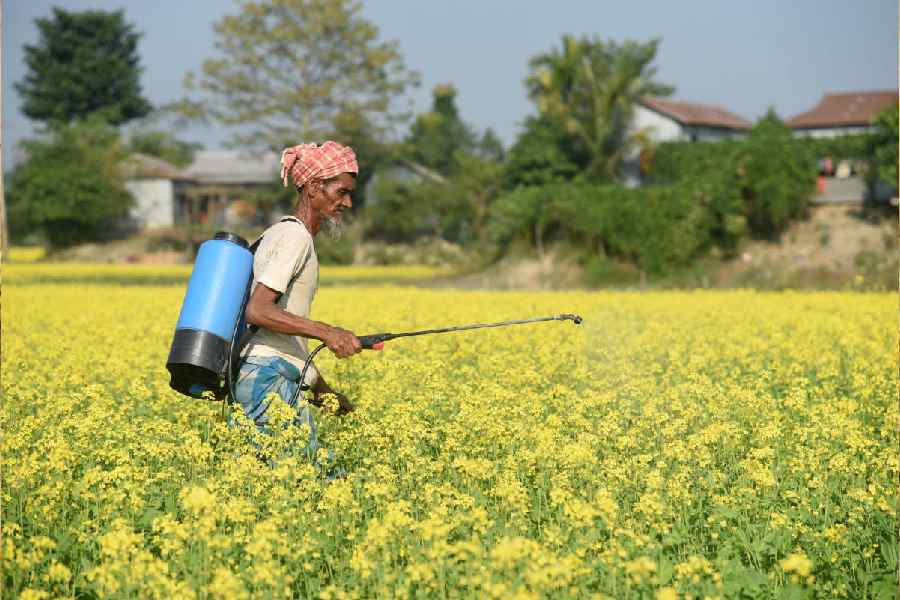Declining water table
Indian voters braved the worst spell of heat in years to queue up at polling booths. Record-breaking temperatures coupled with acute water scarcity. The water in 150 major reservoirs dropped to 23 per cent. Southern India was most affected with 14 per cent drop in water level. Bengaluru and Chennai were among the worst-hit cities where people stood in queue for hours to collect water from tankers. The villages of Haryana’s Nuh — around 30 of them — are in a perpetual state of drinking water crisis. This year, ahead of the elections, villagers let it be known to polling agents of parties that they would vote for whoever ensured free water tankers. Water scarcity is more than a social or environmental concern, it is a crisis that is going to hit the nation’s economy. Inadequate water supply does not just strain urban infrastructure, it also chokes agricultural and industrial productivity.

A young Indian girl drawing water from a well. Thar Desert, Rajasthan. Getty images
So what can one do? Well, stringent water governance policies to regulate usage and prioritising investments in water infrastructure projects to enhance supply and distribution networks are the need of the hour.
Startle Stat
DELHI
Total water production from May 21 to May 31: between 977.79 and 993.76 million gallons per day (MGD)
Daily demand: 1,290 MGD
(The Delhi Jal Board Summer Bulletin)
BENGALURU
14,000 public borewells
6,900 of them have gone dry
Food contamination
General elections were already underway when food safety authorities of the European Union flagged the presence of cancer-causing chemicals in 527 food products originating from India. From heavy metals such as lead and mercury to high levels of pesticides and fungicides to contaminants banned for decades — these were found in cereals, nuts, fruits, vegetables, herbs and spices. The issue got attention shortly after Indian spice brands, including Everest and MDH, were banned in Hong Kong and Singapore. High levels of contamination indicate use of pesticides. The food items flagged by EU food safety authorities contain ethylene oxide, a cancer-causing chemical. Ethylene oxide is added during processing. This exposes not just the failure of India’s food regulator, the Food Safety and Standards Authority of India or FSSAI, but also an unbridled industry that compromises on food safety.
Is it so difficult for our politicians to put in place an effective monitoring mechanism and enforce science- based standards?
Startle Stat
This year, the FSSAI increased the maximum residue limit of pesticides in herbs and spices from 0.01mg/kg to 0.1 mg/kg — which works out to 10 times more
Poor air quality
India is home to seven of the world’s 10 most polluted cities. Multiple studies show poor air quality is a hazard, causing millions of deaths. What is more, future generations grow up with the reality of reduced lung capacities. According to a study published in Lancet Planetary Science, in 2019, 16.7 lakh Indians died because of air pollution. This resulted in a 1.36 per cent loss of GDP, which is equivalent to Rs 2.7 lakh crore. These elections, air pollution found place in the manifestoes of the BJP, Congress, DMK and Trinamool. In its 2019 manifesto, the BJP promised a comprehensive clean air programme in 102 cities to reduce pollution by 35 per cent in five years.

New Delhi: A man runs on the Kartavya Path amid dense smog near the India Gate in New Dellhi, Saturday, Nov. 4, 2023. Delhi-NCR region is winessing smog amid a surge in farm fires and unfavourable weather conditions leading to a spike in the air pollution levels. PTI
Not only has nothing been done to turn that into reality, on the contrary, the government passed contentious environmental laws such as the Forest Conservation (Amendment) Bill, 2023, and the Biodiversity (Amendment) Bill, 2023, which further weakened environmental protection. Industry got a free hand to flout environmental norms, all for the sake of maximising profit.
Startle Stat
India’s PM 2.5 concentration value exceeds WHO’s guideline value of 5 μg/m3 by over 10 times, according to the 2023 World Air Quality Report. PM 2.5 is an indicator of air quality. PM stands for particulate matter
Shrinking farmland
The protests against the three farm laws in 2020-21 were one of the most serious challenges the Modi 2.0 government had to face. The latter was forced to repeal the laws, but the farmers’ agitation continued to simmer till early this year. Naturally, farmers’ issues featured prominently in the manifestoes of most political parties. The Congress promised a “legal guarantee” for minimum support prices of essential crops and also to bolster the marketing system for farmers. The BJP’s core agricultural vision has to do with investments in agri-infrastructure, agri-processes and corporate-style agriculture. No manifesto addressed the issues of shrinking farmland and land degradation.

Barpeta, Assam, India. 14 December 2021. A farmer sprays fertilizer in his mastered field in a village in Barpeta district of Assam. Getty images
Apart from losses due to natural calamities, individual farm holdings shrunk because of increasing population and altering family sizes. More than
80 per cent farmers in India has less than 2 hectares of farmland, precisely 0.6 hectares on an average, not enough to produce crop surplus that can financially sustain their families. Farm loans and dole do not address the issue of shrinking farmland of small farmers which run the risk of getting concentrated in the hands of the wealthy and the corporates. Some day soon, this will cast a long shadow on our food security.
Startle Stat
India has lost 70 million hectares of farmland — about the size of Afghanistan — since 2015, according to data released by the ministry of agriculture in 2023.

Abandoned - shed - Tata Nano factory - Singur. File picture
On the other hand, the country’s built-up area has increased over the past 17 years, expanding by almost 2.5 million hectares
Illegal mining
According to the ministry of mines, Government of India, “There is enormous and large-scale multi-state illegal mining of iron ore and manganese ore running into thousands of crores every year, having several pernicious evil effects on the national economy, good governance, public functionaries, bureaucracy, public order, law and order.” It states that illegal mining has encouraged rampant corruption at different levels of public life and adds, “It is not only national loot, but it also has deleterious effects on the national economy and society. This has to be stopped immediately and effectively.” Despite such strong words, just before the general elections, the BJP welcomed illegal mining accused G. Janardhana Reddy into the saffron fold in Karnataka. Apart from minerals, illegal mining of sand and stone is rampant across the states. Indiscriminate extraction of sand from the riverbed has damaged several rivers and caused floods.
Startle Stat
Between January 2019 and November 2020, every month at least 8 people lost their lives due to illegal sand mining










